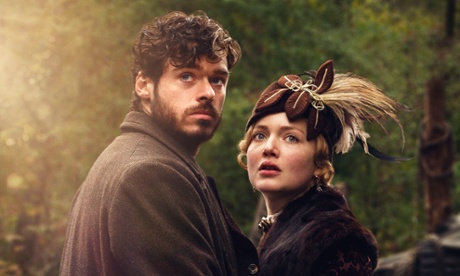
The BBC’s advance publicity for its new adaptation of Lady Chatterley’s Lover (Sunday, 9pm, BBC1) has stressed how unlikely viewers are to be shocked by the visuals and verbals in its sex scenes.
This claim is confirmed by a preview, in which it’s clear that writer-director Jed Mercurio has concentrated on class rather than the c-word that made DH Lawrence’s novel the subject, in 1960, of Britain’s most celebrated literary obscenity trial. Mercurio’s impressively economical adaptation – the opening scenes are a model of how to rattle through chapters of back-story – often feels more like another famous novel published three years before Lawrence’s: F Scott Fitzgerald’s The Great Gatsby.
However, even a TV-maker as talented as Mercurio – whose Cardiac Arrest, Line of Duty and Critical resuscitated the medium’s sclerotic cop and doc genres – can’t overcome the problem that a Lawrence dramatisation that decides (or is forced by BBC guidelines) neither to show nor to speak of genitals is as perverse as a calorie-controlled Great British Bake-Off or a politically correct Top Gear.
The problem, though, may be that television has never been good at sex. Whereas the sexual descriptions and conversations in Lawrence’s book genuinely challenged the social and publishing conventions of its time, TV’s best-remembered sexual controversy in fiction involved a naked female bottom glimpsed in Dennis Potter’s The Singing Detective in 1987. That the buttocks were adulterous as well as unclothed may have contributed to the horror of the morality campaigner Mrs Mary Whitehouse, who became so inflamed that she wrongly claimed the scene to have been based on an infidelity of the playwright’s mother, and had to apologise and pay up.
For those who argue that what really shocked the British establishment about Lady Chatterley was that its sex scenes transgressed class boundaries, it’s striking that past controversies about erotic content on TV have most often involved departures from another surface convention of the ruling class: heterosexuality.
Newspaper outrage over the original series of Queer as Folk in 1999 condemned the explicit sexual depictions, but the reaction seemed clearly exacerbated by the fact that the scenes featured two men. Similarly, a single fully clothed kiss on the lips brought bigoted complaints against Brookside in 1984 and EastEnders in 2014 because the embraces involved two women and two men respectively.
One obvious reason that we don’t see or hear much about sex on TV is that it has been screened out in advance; in broadcasting, the majority of censorship has always been self-censorship.
For instance, nudity on TV has never been anywhere near as rife as lobbyists claim, although it has always been reliably sexist: the ratios of breasts to penises shown over time must be about 100 to 1. That imbalance, though, is not entirely due to the prejudices of male executives. As erections remain a taboo in both broadcasting guidelines and law, it is impossible to depict a man in a sex scene realistically.
In other cases and other ways, executive prurience, in the cause of protecting the audience, regularly achieves the sort of ban that the UK courts failed to impose on Lady Chatterley. Only a fraction of these excisions are ever known about.
A gay sex scene was cut from Footballers’ Wives before transmission and, in 1979, the BBC cancelled, just before filming, Ian McEwan’s adaptation of his short story Solid Geometry, apparently fearing the reaction of the just-elected Thatcher administration to a drama that featured a pickled penis in a jar and a naked sex scene involving inventive positions.
One of the many failures of BBC management in this matter (which included sacrificing the producer to the puritans) was to have read the script as if it were a novel, a latter-day Chatterley, assuming that the stage directions would somehow reach the public directly.
But, as McEwan pointed out in an article about the affair, whereas Lawrence was working in a form in which he had to tell us what he wanted us to see: “The camera has to be told how and what to look at.”
The possible obliqueness of TV is the reason that the medium has never had an equivalent to the Chatterley scandal. From the multiple adulteries of Bouquet of Barbed Wire in 1976 to the lesbian relationships in Tipping the Velvet almost three decades later, a lot was left to the viewers’ imagination.
Through an actor sliding downwards out of shot, or the camera gliding upwards, the medium alluded for years to sexual acts that it would have been unimaginable to show, although this did not prevent some moralists from filling in the blanks and being offended anyway.
In the case of Dennis Potter’s Brimstone and Treacle, for example, which was banned by the BBC in 1976 and not screened until 1987, the moral objection of executives related to the context of the scene – a man who might be the devil raping a severely disabled young woman – rather than to its visual content.
Another example of this gap between presentation and perception is the intermittent telly rows about incest: from LWT’s Bouquet of Barbed Wire in 1976 to brother-sister and cousin-cousin love affairs in Brookside and EastEnders, and, most recently, the inter-familial breeding of Cersei Lannister in Game of Thrones. Yet, not least because actors playing relatives very rarely resemble each other, bloodline love on screen looks no different from any other kind: for the scene to work, the couple have to talk more about their parents than is normal in pillow talk. So those appalled by such a scene are projecting their own outrage on to what is shown.
Time tends to dissolve controversies over content: Channel 4 broadcast a version of Solid Geometry in 2002 without fuss. Conversely, a version of Lady Chatterley’s Lover that was verbally and visually accurate to the book could still prove hugely controversial, but the proprieties of BBC1 peak-time have prevented that from happening.

